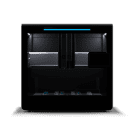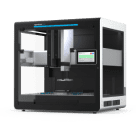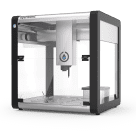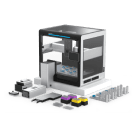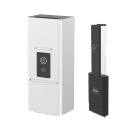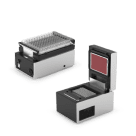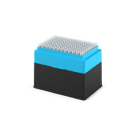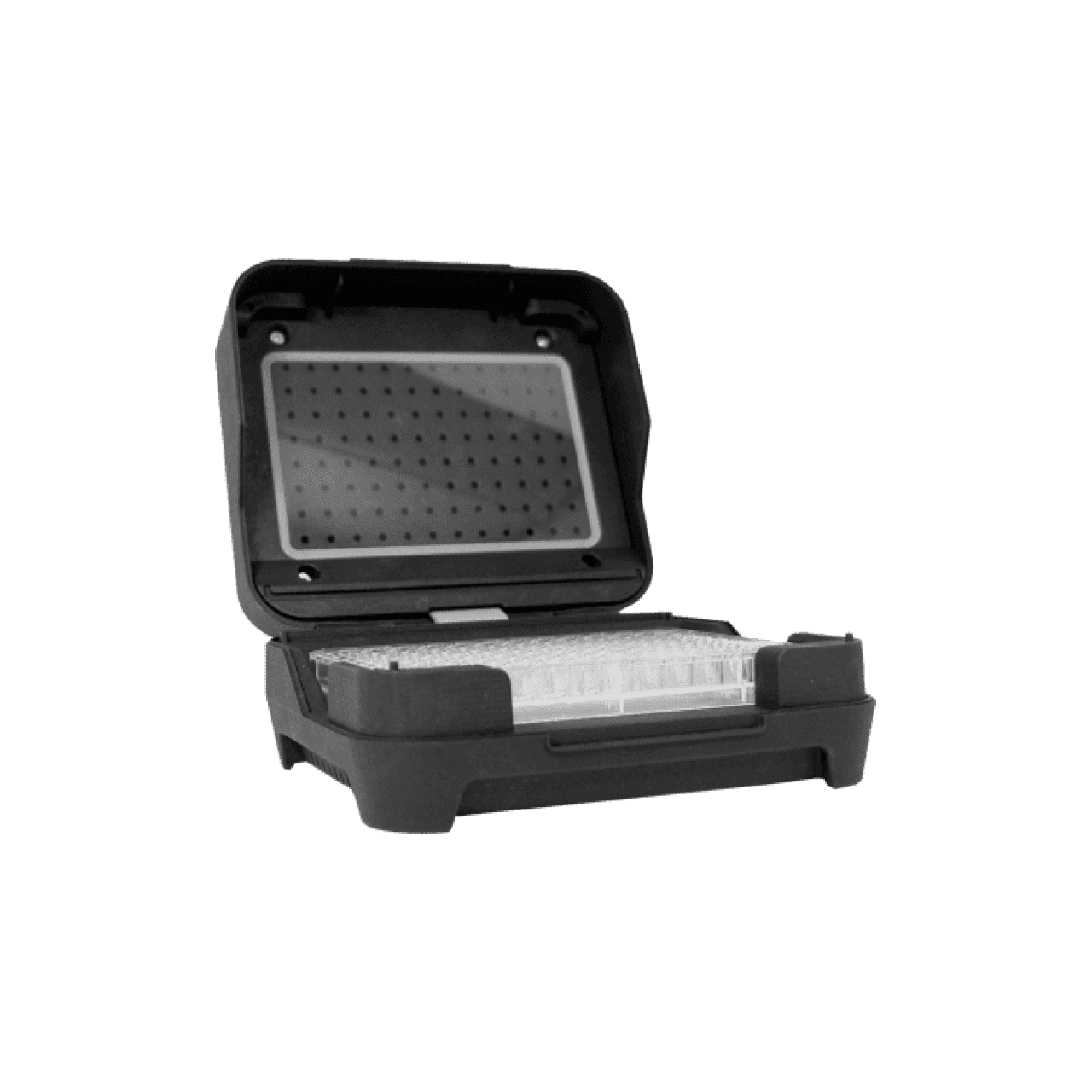Order of Operations¶
Complex commands perform a series of building block commands in order. In fact, the run preview for your protocol in the Opentrons App lists all of these commands as separate steps. This lets you examine what effect your complex commands will have before running them.
This page describes what steps you should expect the robot to perform when using different complex commands with different required and optional parameters.
Step Sequence¶
The order of steps is fixed within complex commands, but legacy and liquid class complex commands handle transfer steps and changes to actions differently.
In a transfer(), aspiration and dispensing are the only required actions. You can enable or disable all of the other actions with complex liquid handling parameters. A transfer() command designed to perform every possible action will proceed in this order:
Pick up tip
Mix at source
Aspirate from source
Touch tip at source
Air gap
Dispense into destination
Mix at destination
Touch tip at destination
Blow out
Drop tip
In a transfer_with_liquid_class(), your chosen liquid class definition specifies nearly all transfer behavior your Flex pipette will perform, like position information. For more information, see Liquid Class Definitions.
A liquid class definition with every action enabled would proceed in this order:
To aspirate:
Pick up tip
Submerge into the source well to the aspirate position
Delay for an amount of time
Mix at the aspirate position
Pre-wet the attached tip at the aspirate position
Aspirate from the source well
Delay for an amount of time
Retract from the source well to the specified position
Touch tip at the source well
Add an air gap
To dispense:
Move to and submerge into the destination well to the dispense position
Delay for an amount of time
Dispense into the destination well
Push out into the destination well
Delay for an amount of time
Mix at the dispense position
Retract from the destination well to the specified position
Delay for an amount of time
Blow out at the specified location
Touch tip at the blow out location
Drop tip
Note
If you specify a blowout at a location other than the destination well, the pipette will touch the tip at the destination well and add an air gap before continuing to the blowout location.
In addition, the pipette will always touch the tip after a blowout.
Each command may repeat some or all of these steps in order to move liquid as requested. transfer() repeats as many times as there are wells in the longer of its source or dest arguments. Both legacy and liquid class distribute and consolidate methods try to repeat as few times as possible. See Tip Refilling below for how they behave when they do need to repeat.
Example Orders¶
The smallest possible number of steps in a complex command like transfer() is just two: aspirating and dispensing. This is possible by omitting the tip pickup and drop steps:
pipette.transfer(
volume=100,
source=plate["A1"],
dest=plate["B1"],
new_tip="never",
)
You can also use new_tip="never" to reuse pipette tips and decrease the total number of steps in any liquid class complex command.
Here’s another example, a distribute command that adds touch tip steps (and does not turn off tip handling). The code for this command is:
pipette.distribute(
volume=100,
source=[plate["A1"]],
dest=[plate["B1"], plate["B2"]],
touch_tip=True,
)
Compared to the list of all possible actions, this code will only perform the following:
Pick up tip
Aspirate from source
Touch tip at source
Dispense into destination
Touch tip at destination
Blow out
Drop tip
Let’s unpack this. Picking up and dropping tips is default behavior for distribute(). Specifying touch_tip=True adds two steps, as it is performed at both the source and destination. And it’s also default behavior for distribute() to aspirate a disposal volume, which is blown out before dropping the tip. The exact order of steps in the run preview should look similar to this:
Picking up tip from A1 of tip rack on 3
Aspirating 220.0 uL from A1 of well plate on 2 at 92.86 uL/sec
Touching tip
Dispensing 100.0 uL into B1 of well plate on 2 at 92.86 uL/sec
Touching tip
Dispensing 100.0 uL into B2 of well plate on 2 at 92.86 uL/sec
Touching tip
Blowing out at A1 of Opentrons Fixed Trash on 12
Dropping tip into A1 of Opentrons Fixed Trash on 12
Since dispensing and touching the tip are both associated with the destination wells, those steps are performed at each of the two destination wells.
If you use distribute_with_liquid_class() to perform the same transfer, the liquid class definition automatically determines transfer behaviors like touch tip and blow out. For more information on automatic changes to transfer steps, see the Liquid Class Definitions.
Tip Refilling¶
One factor that affects the exact order of steps for a complex command is whether the amount of liquid being moved can fit in the tip at once. If it won’t fit, you don’t have to adjust your command. The API will handle it for you by including additional steps to refill the tip when needed.
For example, say you need to move 100 µL of liquid from one well to another, but you only have a 50 µL pipette attached to your robot. To accomplish this with building block commands, you’d need multiple aspirates and dispenses. aspirate(volume=100) would raise an error, since it exceeds the tip’s volume. But you can accomplish this with a single command:
pipette50.transfer(
volume=100,
source=plate["A1"],
dest=plate["B1"],
)
To effect the transfer, the API will aspirate and dispense the maximum volume of the pipette (50 µL) twice:
Picking up tip from A1 of tip rack on D3
Aspirating 50.0 uL from A1 of well plate on D2 at 57 uL/sec
Dispensing 50.0 uL into B1 of well plate on D2 at 57 uL/sec
Aspirating 50.0 uL from A1 of well plate on D2 at 57 uL/sec
Dispensing 50.0 uL into B1 of well plate on D2 at 57 uL/sec
Dropping tip into A1 of Opentrons Fixed Trash on A3
You can change volume to any value (above the minimum volume of the pipette) and the API will automatically calculate how many times the pipette needs to aspirate and dispense. volume=50 would require just one repetition. volume=75 would require two, split into 50 µL and 25 µL. volume=1000 would repeat 20 times — not very efficient, but perhaps more useful than having to swap to a different pipette!
Remember that distribute() includes a disposal volume by default, and this can affect the number of times the pipette refills its tip. Say you want to distribute() 80 µL to each of the 12 wells in row A of a plate. That’s 960 µL total — less than the capacity of the pipette — but the 100 µL disposal volume will cause the pipette to refill.
Picking up tip from A1 of tip rack on 3
Aspirating 980.0 uL from A1 of well plate on 2 at 274.7 uL/sec
Dispensing 80.0 uL into B1 of well plate on 2 at 274.7 uL/sec
Dispensing 80.0 uL into B2 of well plate on 2 at 274.7 uL/sec
...
Dispensing 80.0 uL into B11 of well plate on 2 at 274.7 uL/sec
Blowing out at A1 of Opentrons Fixed Trash on 12
Aspirating 180.0 uL from A1 of well plate on 2 at 274.7 uL/sec
Dispensing 80.0 uL into B12 of well plate on 2 at 274.7 uL/sec
Blowing out at A1 of Opentrons Fixed Trash on 12
Dropping tip into A1 of Opentrons Fixed Trash on 12
This command will blow out 200 total µL of liquid in the trash. If you need to conserve liquid, use complex liquid handling parameters to reduce or eliminate the disposal volume, or to blow out in a location other than the trash.
List of Volumes¶
Legacy complex commands like transfer() can aspirate or dispense different amounts for different wells, rather than the same amount across all wells. Liquid class complex commands, like transfer_with_liquid_class() only accept a single volume argument, and aspirate or dispense the same amount across wells.
To do this in a transfer(), set the volume parameter to a list of volumes instead of a single number. The list must be the same length as the number of source or dest (or the longer of the two for a transfer()), or the API will raise an error. For example, this command transfers a different amount of liquid into each of wells B1, B2, and B3:
pipette.transfer(
volume=[20, 40, 60],
source=plate["A1"],
dest=[plate["B1"], plate["B2"], plate["B3"]],
)
Setting any item in the list to 0 will skip aspirating and dispensing for the corresponding well. This example takes the command from above and skips B2:
pipette.transfer(
volume=[20, 0, 60],
source=plate["A1"],
dest=[plate["B1"], plate["B2"], plate["B3"]],
)
The pipette dispenses in B1 and B3, and does not move to B2 at all.
Picking up tip from A1 of tip rack on 3
Aspirating 20.0 uL from A1 of well plate on 2 at 274.7 uL/sec
Dispensing 20.0 uL into B1 of well plate on 2 at 274.7 uL/sec
Aspirating 60.0 uL from A1 of well plate on 2 at 274.7 uL/sec
Dispensing 60.0 uL into B3 of well plate on 2 at 274.7 uL/sec
Dropping tip into A1 of Opentrons Fixed Trash on 12
This is such a simple example that you might prefer to use two transfer() commands instead. Lists of volumes become more useful when they are longer than a couple elements. For example, you can specify volume as a list with 96 items and dest=plate.wells() to individually control amounts to dispense (and wells to skip) across an entire plate.
Note
When the optional new_tip parameter is set to "always", the pipette will pick up and drop a tip even for skipped wells. If you don’t want to waste tips, pre-process your list of sources or destinations and use the result as the argument of your complex command.
New in version 2.0: Skip wells for transfer() and distribute().
New in version 2.8: Skip wells for consolidate().

